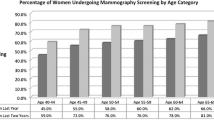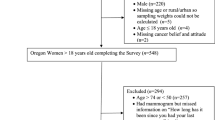Abstract
Background Obesity is associated with increased post-menopausal breast cancer risk. Overweight and obese women also tend to have a poorer prognosis when diagnosed with breast cancer compared with their matched normal weight peers. In previous studies obesity was associated with decreased utilization of screening mammography. We present a study examining the association between Body Mass Index (BMI) and compliance with recommended mammographic screening using data from the 2004 Behavioral Risk Factor Surveillance Survey (BRFSS). Patients and methods We included 130,185 female participants, aged 40 and older, who were randomly selected to participate in the world largest telephone survey. After weighted analysis, this is representative of 56,226,220 non-institutionalized US women. The primary outcome was the proportion of women who underwent screening mammography within the last 2 years preceding the survey stratified by BMI. The mammography screening behavior of normal weight women (BMI 18.5–24.99) was compared with underweight (<18.5), overweight (25–29.99), and women with obesity class I (30–34.99), class II (35–39.99), and class III (≥40) using logistic regression analysis and weighted to provide estimates of women in the United States (US). Results Our sample included 1.91% underweight, 37.91% normal weight, 30.15% overweight and 14.36%, 5.44%, and 3.49% women with obesity classes’ I–III respectively. Approximately 7% of women age 40 and older had insufficient information to calculate their BMI. Adjusting for age, race, smoking status, general health perception, level of education, and income level, underweight women had lower odds of complying with regular screening mammography (OR 0.57; 95% CI, 0.48–0.68). Women with obesity class III (OR 0.97; 95% CI, 0.84–1.13) showed a trend towards underutilization of screening mammograms which was not clinically significant. In contrary, in overweight women a significantly higher association with appropriate mammography utilization was identified OR 1.08 (95% CI, 1.01–1.15). Although not statistically significant, women with class I and II obesity showed a trend towards a higher utilization 1.08 (95% CI, 0.99–1.18) and 1.10 (95% CI, 0.98–1.25) respectively, when compared to women at desired weight. Conclusion We present a weighted analysis of the BRFSS, evaluating the association of BMI and appropriate screening mammography among women 40 years and older. These results are generalizable to the US population of women in this age range. Underweight women had significantly lower odds of utilizing screening mammography appropriately when compared with women at desired weight. Results from previous studies reporting underutilization of screening mammography in high risk, obese, and overweighed women were not confirmed in this largest population based analysis performed to date.

Similar content being viewed by others
Explore related subjects
Discover the latest articles and news from researchers in related subjects, suggested using machine learning.References
Jemal A, Siegel R, Ward E et al (2007) Cancer statistics. CA Cancer J Clin 57:43–66
Chu KC, Tarone RE, Kessler LG et al (1996) Recent trends in U.S. breast cancer incidence, survival, and mortality rates. J Natl Cancer Inst 88:1571–1579
Berry DA, Cronin KA, Plevritis SK et al (2005) Effect of screening and adjuvant therapy on mortality from breast cancer. N Engl J Med 353:1784–1792
van den Brandt PA, Spiegelman D, Yaun SS et al (2000) Pooled analysis of prospective cohort studies on height, weight, and breast cancer risk. Am J Epidemiol 152:514–517
Lahmann PH, Hoffmann K, Allen N et al (2004) Body size and breast cancer risk: findings from the european prospective investigation into cancer and nutrition (EPIC). Int J Cancer 111:762–771
Eliassen AH, Colditz GA, Rosner B et al (2006) Adult weight change and risk of postmenopausal breast cancer. JAMA 296:193–201
Morimoto LM, White E, Chen Z et al (2002) Obesity, body size, and risk of postmenopausal breast cancer: the women’s health initiative (United States). Cancer Causes Control 13:741–751
Feigelson HS, Jonas CR, Teras LR et al (2004) Weight gain, body mass index, hormone replacement therapy, and postmenopausal breast cancer in a large prospective study. Cancer Epidemiol Biomarkers Prev 13:220–224
Carmichael AR (2006) Obesity as a risk factor for development and poor prognosis of breast cancer. BJOG 113(10):1160–1166
Loi S, Milne RL, Friedlander ML et al (2005) Obesity and outcomes in premenopausal and postmenopausal breast cancer. Cancer Epidemiol Biomarkers Prev 14(7):1686–1691
Fontaine KR, Heo M, Allison DB (2001) Body weight and cancer screening among women. J Womens Health Gend Based Med 10(5):463–470
Wee CC, McCarthy EP, Davis RE et al (2000) Screening for cervical and breast cancer: is obesity an unrecognized barrier to preventive care? Ann Intern Med 132(9):697–704
Fontaine KR, Faith MS, Cheskin LJ et al (1998) Body weight and health care among women in the general population. Arch Fam Med 7(4):381–384
Miller D, Martin I, Herbison P (2002) Interventions for relieving the pain and discomfort of screening mammography. Cochrane Database Syst Rev: CD002942
Kornguth PJ, Rimer BK, Conaway MR et al (1993) Impact of patient-controlled compression on the mammography experience. Radiology 186:99–102
Behavioral risk factor surveillance system: codebook 2002, (2005) United States Department of Health and Human Services, Centers for Disease Control and Prevention, Atlanta
Periodic Health Examinations (2008) Summary of AAFP policy recommendations and age charts. http://www.aafp.org/exam.xml. Accessed 25 Feb 2008
U.S. Preventive Services Task Force (2008) Guide to clinical preventive services, 3rd edn. http://www.ahrq.gov/clinic/uspstfix.htm. Accessed 25 Feb 2008
Randolph WM, Goodwin JS, Mahnken JD, Freeman JL (2002) Regular mammography use is associated with elimination of age-related disparities in size and stage of breast cancer at diagnosis. Ann Intern Med 137:783–790
McCarthy EP, Burns RB, Freund KM et al (2000) Mammography use, breast cancer stage at diagnosis, and survival among older women. J Am Geriatr Soc 48:1226–1233
Smith-Bindman R, Kerlikowske K, Gebretsadik T, Newman J (2000) Is screening mammography effective in elderly women? Am J Med 108:112–119
National Heart, Lung and Blood Institute (1998) Clinical guidelines on the identification, evaluation and treatment of overweight and obesity in adults—the evidence report. Obes Res 6(Suppl 2):51S–209S
Rahman SM, Dignan MB, Shelton BJ (2003) Factors influencing adherence to guidelines for screening mammography among women aged 40 years and older. Ethn Dis 13(4):477–484
Fernandez ME, Palmer RC, Leong-Wu CA (2005) Repeat mammography screening among low-income and minority women: a qualitative study. Cancer Control 12(Suppl 2):77–83
Gopinath P, Wan E, Holdcroft A et al (2005) Increased capsaicin receptor TRPV1 in skin nerve fibres and related vanilloid receptors TRPV3 and TRPV4 in keratinocytes in human breast pain. BMC Womens Health 5(1):2–6
Olson CL, Schumaker HD, Yawn BP (1994) Overweight women delay medical care. Arch Fam Med 3:888–892
Zayat EN, Fontaine KR, Cheskin LJ (1999) Use of preventive health care services by patients with obesity. Obes Res 7:223–226
Cochrane Database Syst Rev (23 Jan 2008) (1):CD002942
Cohen SS, Palmieri RT, Nyante SJ et al (2008) A review: obesity and screening for breast, cervical, and colorectal cancer in women. Cancer Mar 24 Epub/Accessed 30 March 2008
Lantz PM, House JS, Lepowski JM, Williams DR, Mero RP, Chen J (1998) Socioeconomic factors, health behaviors and mortality: results from a nationally representative prospective study of U.S. adults. JAMA 279:1703–1708
Author information
Authors and Affiliations
Corresponding author
Rights and permissions
About this article
Cite this article
Berz, D., Sikov, W., Colvin, G. et al. ‘Weighing in’ on screening mammography. Breast Cancer Res Treat 114, 569–574 (2009). https://doi.org/10.1007/s10549-008-0037-y
Accepted:
Published:
Issue Date:
DOI: https://doi.org/10.1007/s10549-008-0037-y




